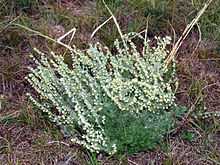Artemisia frigida
| Artemisia frigida | |
|---|---|
 | |
| Conservation status | |
| Scientific classification | |
| Kingdom: | Plantae |
| (unranked): | Angiosperms |
| (unranked): | Eudicots |
| (unranked): | Asterids |
| Order: | Asterales |
| Family: | Asteraceae |
| Genus: | Artemisia |
| Species: | A. frigida |
| Binomial name | |
| Artemisia frigida Willd. | |
Artemisia frigida is a species of flowering plant in the aster family known by the common names fringed sagebrush, prairie sagewort, arctic sage and pasture sage (however it is not closely related to the true sages Salvia). It is native to Europe, Asia, and much of North America, in Canada and the western United States.[1] In parts of the north-central eastern United States it is an introduced species.[2]
This plant is a perennial plant[1] but with a woody base.[2] The stems spread out, generally forming a mat or clump up to 40 centimetres (1.3 ft) tall. The stems are covered in lobed gray-green leaves which are coated in silvery hairs. The inflorescence contains many spherical flower heads each about half a centimeter wide and lined with woolly-haired, gray-green or brownish phyllaries. The flower heads contain several pistillate ray florets and many bisexual disc florets. The plant is aromatic, with a strong scent.[1][2] This plant can make a great many seeds.[3] It can also spread by layering; in some years it produces very few seeds.[2]
This plant is common and dominant or codominant in many areas, especially in dry and disturbed habitat types. It is common in the Rocky Mountains and Great Plains in North America, where it occurs in grasslands, shrublands, and woodlands, among others. It has a tendency to increase in areas that have been heavily grazed by livestock. Overgrowth of the plant is sometimes an indicator of overgrazing on rangeland.[2] It sometimes becomes an aggressive weed.[3][4] Ranchers have considered the plant to be both an adequate forage species and a worthless nuisance species.[2]
A number of wild animals consume the plant, including white-tailed jackrabbits and sage grouse.[2]
The plant is cultivated for its foliage effects, and has gained the Royal Horticultural Society's Award of Garden Merit.[5]
This sagebrush had a variety of uses for Native American groups.[6] It was used medicinally for coughs, colds, wounds, and heartburn by the Blackfoot. The Cree people used it for headache and fever and the Tewa people took it for gastritis and indigestion. It also had ceremonial and veterinary applications, including for the Blackfoot, who reportedly used the crushed leaves to "revive gophers after children clubbed them while playing a game".[7] Among the Zuni, the whole plant is made into an infusion for colds. Sprigs of this plant and corn ears are attached to decorated tablets and carried by female dancers in a drama. The sprigs are also dipped in water and planted with corn so the corn will grow abundantly.[8]
This plant is also used in landscaping and for erosion control and revegetation of rangeland.[2] It is drought-resistant.[3][9]
References
- ↑ 1.0 1.1 1.2 Leila M. Shultz (2006). "Artemisia frigida". Magnoliophyta: Asteridae, Part 6: Asteraceae, Part 1. Flora of North America 19. Oxford University Press. p. 519. ISBN 978-0-19-530563-0.
- ↑ 2.0 2.1 2.2 2.3 2.4 2.5 2.6 2.7 McWilliams, Jack (2003). Artemisia frigida. In: Fire Effects Information System, [Online]. U.S. Department of Agriculture, Forest Service, Rocky Mountain Research Station, Fire Sciences Laboratory. Retrieved December 30, 2011.
- ↑ 3.0 3.1 3.2 Peat, H. C. & G. G. Bowes (1994). "Management of fringed sagebrush (Artemisia frigida) in Saskatchewan". Weed Technology 8 (3): 553–558. JSTOR 3988028.
- ↑ Wilson, R. G. (1982). "Germination and seedling development of fringed sagebrush (Artemisia frigida)". Weed Science 30 (1): 102–105. JSTOR 4043228.
- ↑ "RHS Plant Selector - Artemisia frigida". Retrieved 21 July 2013.
- ↑ Artemisia frigida. USDA NRCS Plant Guide. Retrieved December 30, 2011.
- ↑ Artemisia frigida. University of Michigan Ethnobotany. Retrieved December 30, 2011.
- ↑ http://herb.umd.umich.edu/herb/search.pl?searchstring=zuni
- ↑ Artemisia frigida. US Forest Service. Retrieved December 30, 2011.
External links
| Wikimedia Commons has media related to Artemisia frigida. |
